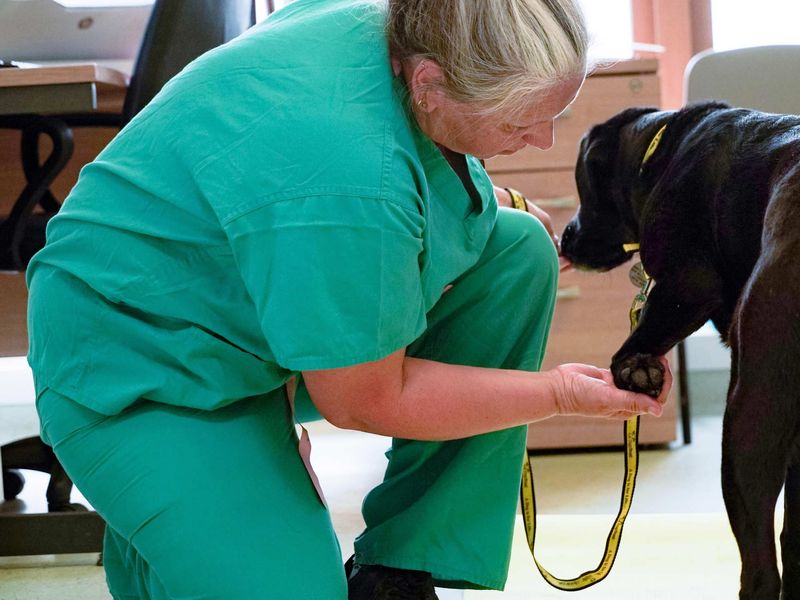How does pain affect behaviour?
Underlying health conditions can affect canine behaviour. We examine how common clinical signs relate to behaviour.

Health, pain and behaviour
Disease processes can affect any animal's ability to behave 'normally', and owner-reported behavioural changes may be the first indication of a sub-clinical condition.
How underlying conditions can affect canine behaviour
Underlying health condition symptom | Behavioural change |
|---|---|
Disruption to normal anatomical function
| Temporarily or permanently limited mobility might affect a dog’s ability to communicate effectively and avoid or escape from uncomfortable situations. Anxiety might be further increased by a dog being unable to perform normal coping mechanisms. Loss of sensory ability, such as blindness or deafness, might affect perception and confidence, potentially increasing general anxiety and vulnerability. |
Polydipsia
| Might result in feelings of anxiety around water sources and/or reluctance to move away from these. |
Polyphagia
| Might result in increased scavenging, begging, and anxiety and frustration around food and access to food, which could lead to resource guarding. |
Lethargy/ataxia
| Might result in reduced motivation for interaction or exercise, as well as increased irritability. |
| Pain, discomfort | A dog might appear reluctant to be handled or suddenly become aggressive upon handling or being encouraged to move. Self-trauma might be seen in some dogs, for example, repeated licking over a painful joint might create a granuloma. |
| Medical or surgical interventions | Medications may cause side effects that affect behaviour either through increasing thirst and hunger (such as steroids) or influencing mood. Surgical interventions might require recovery periods during which normal behaviours are restricted, which might create frustration or dejection. |
What is pain?
Pain is defined as 'an unpleasant sensory and emotional experience associated with actual or potential tissue damage or described in terms of such damage'. Namely, pain may be experienced with or without physical damage to the body and is subjective and unique to every individual.
Although pain is the endpoint of nociceptive input, autonomic pathways and areas of the brain involved in emotion and memory are also implicated, so it becomes a multi-dimensional experience. There are many different types of pain, including neuropathic, somatic and visceral pain, which can then also be either acute or chronic depending on duration.
Physiological pain is essential for survival as it facilitates the identification of potentially harmful stimuli that can subsequently be avoided, and also allows for convalescence.
How does pain affect behaviour?
Animals are nonverbal and cannot self-report the presence of pain, therefore the burden of pain assumption, recognition, and assessment lies with veterinary professionals. It is now accepted that the most accurate method for evaluating pain in animals is not by physiological parameters but by observations of behaviour.
Obtaining a thorough patient history from the owner can help determine abnormal behaviour patterns that may be pain-related, and home video recordings of the concerning behaviour can be a useful aid to assessment.
Some behaviours that can be caused by pain
Altered social interactions
Whether physical or emotional, pain and/or the anticipation of pain can affect the emotional states of animals by causing stress, anxiety and fear. The anticipation of pain might therefore motivate avoidance or escape behaviours which, as well as retreating and hiding, could involve aggressive behaviour aimed at repelling any stimuli perceived as potentially painful.
Avoidance and aggressive behaviour might also communicate unwillingness to receive or engage in interaction or tactile manipulation (as discussed in aggressive behaviour). Pain might also play a part in separation-related/attention-seeking behaviour, as some dogs might solicit increased social inclusion and desire to be with their owner for greater security and support.
Altered posturing, movement and associated behaviour or willingness to engage in activity
The experience of pain might manifest as altered movement, of the whole body or isolated parts. Lip-smacking or holding the body very still in a bowed stance might occur in response to gastrointestinal pain for example, or star-gazing in response to spinal or dental pain.
Although it can be very difficult to assess, lameness is another more obvious example. However, it is always worth being mindful that pain may be overridden by a dog’s desire to engage in various activities despite the pain experienced.
The possibility that a dog will overcompensate for pain experienced at a localised region of the body, such as a specific limb, and suffer discomfort/result in damage elsewhere within the body is another factor worth considering when assessing a dog for pain.
Altered normal daily routine
Dogs experiencing or anticipating pain might prioritise resting over exercise or other activity, however, it is important to be aware of competing motivations in which the desire to perform a specific behaviour overrides the desire to avoid pain.
For example, a dog with dental disease could still eat, and a dog with arthritis may still want to chase a ball with the same vigour as displayed prior to any pain experienced. This phenomenon, coupled with individual degrees of stoicism, can complicate pain diagnoses.
Altered ability to concentrate and learn
Pain can also negatively affect cognitive ability and interfere with the ability to concentrate and learn, as well as remember things. Pain might be experienced more intensely at night due to the lessening of other distractions, and has been shown to disrupt sleep in dogs, which also contributes to the negative impact of pain upon learning ability. Sleep deprivation also increases the perception of pain and can depress the mood.
Formation of new distraction behaviours
A dog might also attempt to alleviate or cope with physical or emotional pain by performing specific distracting behaviours, for example, licking/nibbling an area of their body or tail-chasing, even if these areas are not the source of pain.
Initially associated with endorphin release, these behaviours make the dog feel better so might be performed repeatedly until they progress into habitual and compulsive behaviour.
This then becomes maladaptive for the individual, causing, for example, dermatitis, lick granulomas, or tail-tip trauma, which can continue long after the initial cause of the pain has been treated and resolved.
Noise sensitivity
Musculoskeletal pain has been positively linked with sensitivity to noise in dogs5. Fagundes, A., et al. 2018, hypothesise that this could be due to the sudden increase in muscle tension which can occur when a dog is startled by a loud noise. In a dog with a pre-existing musculoskeletal condition, this could exacerbate pain.
Negative associations
Another complication with the experience of pain is that an individual might associate it with other concurrent stimuli, which might then impact how they feel about this stimulus when next exposed to it. For example, a dog who runs accidentally into an electric fence and receives an electric shock while out walking in the company of young children might associate the painful experience with the children.
They might consequentially develop anxiety around children as an unfortunate outcome of this association. Another example might be a dog who has experienced dental or neck pain when eating becoming reluctant or worried about eating in general. In this way, painful associations may become generalised more widely.
Analgesia trial
It is worth planning an analgesia trial in combination with behaviour modification in any case where you suspect that the underlying cause of the behaviour change is due to pain. The choice of analgesic and whether one or more agents are required will vary between individuals and depend on factors such as type of pain, (such as musculoskeletal or neurological) as well as the underlying health of the patient, such as whether renal or hepatic compromise is present.
The duration of the analgesia trial should ideally be eight weeks. But six to seven at least to definitively rule out pain as an underlying factor of the behaviour change. Some dogs might also have learned to anticipate a painful response to behaving in a particular way.
In such cases it might be necessary to extend the trial beyond eight weeks, in order to allow time for the behaviour modification programme/training plan to be implemented and for the dog to learn a different way of behaving. This eventuality is worth considering at the start of every pain trial.
References
- Mills, D., Braem Dube, M., & Zulch, H. (2013). Stress and Pheromonatherapy in Small Animal Clinical Behaviour. Chichester: Wiley-Blackwell
- Hedges, S. (2014). Practical Canine Behaviour: For Veterinary Nurses. CABI: Oxfordshire
- International Association for the Study of Pain (1994). Pain terms, a current list with definitions and notes on usage. In: H. Merskey and N. Bogduk (eds) Classification of Chronic Pain, 2nd Edition, IASP Press, Seattle
- Kis, A., Szakadát, S., Gácsi, M. et al. The interrelated effect of sleep and learning in dogs (Canis familiaris); an EEG and behavioural study. Sci Rep 7, 41873 (2017). https://doi.org/10.1038/srep41873
- .Lopes Fagundes, A.L., Hewison, L., McPeake, K.J., Zulch, H., & Mills, D. (2018). Noise Sensitivities in Dogs: An Exploration of Signs in Dogs with and without Musculoskeletal Pain Using Qualitative Content Analysis. Frontiers in Veterinary Science, https://doi.org/10.3389/fvets.2018.00017
- Fellowship of Animal Behaviour Clinicians (FABC) website. Viewed on 10/12/21 https://fabclinicians.org/help-i-think-its-a-behaviour-case/
- Mills, D et al. (2020). Pain and Problem Behaviour in Cats and Dogs. Animals 2020, 10 (2), 318 https://doi.org/10.3390/ani10020318.
Join the Dog Friendly Clinic scheme
Start your journey today by visiting Dog Friendly Clinic Campus and signing up with the key: 4dLsphL2nh2x
Remember to keep note of your username, as you’ll need it each time you log in. If you’re registering on behalf of a clinic, be sure to choose a name that is clear and appropriate for your clinic.
If you don't want to join the scheme but would like to access some of our web pages, visit our Dog Friendly Clinic resources for some of our webpages containing the course content.
Need help?
If you have any questions regarding the scheme or your application, please contact our helpful Dog Friendly Clinic Team.
Disclaimer notice: The advice given on this website [in these materials] is intended for your general information only and should not be relied upon as specific advice for any veterinary practice or clinic. Each veterinary practice or clinic will be unique in its physical environment and each dog attending the veterinary practice or clinic will have specific needs and requirements, which the veterinary practice or clinic is solely responsible for. Unless prohibited by law, Dogs Trust and the British Veterinary Behaviour Association do not accept liability to any person veterinary practice or clinic relating to the use of this information.


